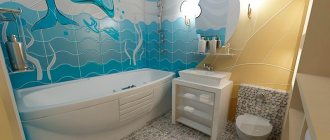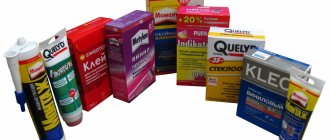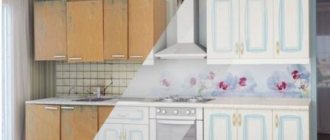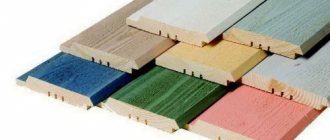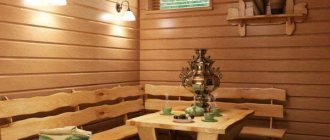Choosing a roller for walls
To choose a suitable roller, you first need to decide what kind of paint you will work with. It is best to paint the internal surfaces of walls with water-based and acrylic painting materials, since they are perfectly diluted with water, are non-toxic, have a high degree of drying, and most importantly, are harmless to the human body. These paints can be used to cover any surface - wooden structures, stone, concrete and brick. Paints allow the wall material to “breathe”, make their surface rich and bright and do not lose their attractive and decorative appearance for a long time.
Wanting to give your interior a unique look, decorative paint is often used. A textured foam roller is suitable for this type of paint. The result is a textured surface after drying.
Modern construction supermarkets offer a huge number of tools and devices of various types, and choosing the right sample sometimes confuses the buyer. How to choose the right nozzle? Paint rollers are classified according to the following criteria:
- 1. Material of the soft paint part of the tool.
On the packaging of a high-quality roller, the product marking is indicated only in Latin letters. This means that high-quality material was used to make the construction tool. The absence of one indicates the low quality of the product. It can only be used for home repairs in small areas.
- 2. Soft element texture.
There are rollers made of artificial and natural materials. Fur tips are the most expensive. Felt and rubber are equivalent to artificial ones. Natural rollers have the highest degree of contact with the surface being treated. According to the method of application, depending on the quality of the nozzle, rollers are divided for walls and floors.
- 3. Shape and size of the roller.
For painting complex configurations and corners, small-sized products are used. The width of the nozzle is of particular importance. To paint small areas in an apartment, it is enough to take a sample 20 - 30 centimeters wide.
So which roller is best to paint walls with water-based paint? The choice of construction tool depends on the composition of the paint and varnish coating and the surface being treated; for example, for applying water-based paint, primer and liquid glue, a regular foam rubber attachment is more suitable.
When planning renovations on their own, many craftsmen wonder what roller to use to paint walls with acrylic paint and water-based compounds? The most popular rollers are foam rubber. This material wears out quickly, but at the same time, it is an inexpensive tool. For smooth walls you need to use fur rollers. The rubber nozzle is more used to create different textures.
Advice. When purchasing a roller for water-based paint for walls, do not forget to purchase additional accessories in the form of an extended holder, a grater and several replacement attachments.
Wall painting process
Painting the walls with water-based paint, done in three layers. To do this, we will need the following working tools: a paint roller, a paint brush, a cuvette (paint bath), a small lamp with an extension cord, a stepladder or a telescopic rod. You can use a spray gun, but not everyone has such a unit on their farm, and purchasing it to paint walls in a small apartment is expensive.
Painted walls with water-based paint design photo ideas
Painting the walls starts from the lighter areas of the rooms to the darker ones, that is, from the windows. To do this, take a roller, pour the previously prepared paint into the cuvette, then thoroughly soak the paint roller in the paint, and roll it over the ribbed part of the cuvette to distribute the paint evenly. It is important to know that if you need to give the walls the effect of an orange peel, then you should choose a roller with a fur coat, but if you just have smooth walls, then it is enough to use a roller with a regular coat.
When painting, do not try to immediately make a saturated color, since after the paint dries, paint joints may remain noticeable; the best option is to make the tone a little lighter, while painting them in several layers. To better control the color and tone of the paint, use additional lighting.
How to paint walls with water-based paint yourself video
Don't try to put a lot of paint on the roller, as the paint will start to splatter. Walls should be painted with water-based paint in parallel stripes, up and down; painting in zigzags is not allowed. Use a brush to paint the corners. Please note that paint the wall only after painting the ceiling.
Advantages and disadvantages
Pros of painting walls with a roller:
- Speed of work . You can quickly paint large areas of surfaces (how to paint walls quickly and professionally?).
- Ease of use . The tool does not require preparation or maintenance, and there is no need to follow complex rules when painting.
- The handle can be extended . By attaching an extension handle, you can reach high areas of the wall.
Minuses:
- It is impossible to paint corners and other complex reliefs and surfaces.
- The need to select a tool depending on the type of paint used.
Tip You can use a roller to paint walls in any room: kitchen, living room, bedroom, bathroom or toilet.
Painting the walls in the kitchen
How to paint the walls in the kitchen? The best paint for kitchen walls, which does not wash off for a long time and is easy to clean. Kitchens, like bathrooms, fog up quite quickly, so it is better to paint them with latex or acrylic-latex paints, which are excellent at resisting moisture and grease and are easy to clean. These paints absorb moisture well and prevent the formation of mold.
Walls are painted with alkyd if you want a glossy shine to the walls. They are not afraid of excessive humidity, but when dry they emit an unpleasant odor, so they can only be painted in a well-ventilated area.
Painted walls in the kitchen
Advantages and disadvantages
Advantages:
- easy to apply to any plastered surface (wood, concrete or gypsum concrete);
- easy to dissolve, and rollers and brushes can be easily washed after work;
- dries quickly, does not peel off;
- non-toxic to people and animals;
- painted surfaces are easy to clean with plain water or any detergent;
- non-flammable, resistant to alkalis;
- some types were specially designed for rooms with high levels of humidity - bathrooms, kitchens;
- service life – up to 20 years;
- capable of masking small cracks (up to 2 mm);
- the price tag is low.
Flaws:
- Water-based paint cannot withstand low temperatures: at temperatures below +5 degrees it loses all its properties, and at 0 it freezes.
- Not suitable for metal, glossy surfaces due to the large amount of liquid in the composition.
- Certain types of coloring solutions have a short service life. Such emulsions are produced less and less often.
Preparing walls for painting with a roller
After purchasing the tools and paint material, you can move on to the next stage - preparing the room for painting. If possible, remove furniture from the room; if this is not possible, then it is compactly placed in the center of the room, completely covered with polyethylene or special capes. To keep windows and door panels clean, use film, securing its ends with masking tape. Skirting boards and door openings are also protected with masking tape.
To effectively paint the entire surface of the walls, it is better to dismantle heating appliances (radiators). For this:
- tightly close the shut-off valves at the entrance to the heating system;
- install a tray under the battery to collect water;
- unscrew the connection points between the device and the general system and drain the water;
- dismantle the radiator.
When all the preparatory work has been completed, we proceed directly to painting. It's best to start with a small area and see how long the paint takes to dry and what the results are. If you like everything, paint the whole room.
Advice. The power supply to the room should be turned off in advance to protect yourself and others from accidental electric shock. Masking tape is applied to open areas with removed sockets.
Some wallpaper requires additional painting after gluing to the wall. Such wallpapers very often help to find quite original and interesting color solutions for interior decoration. How to paint wallpaper for painting? To effectively apply the coloring liquid to the surface, a high-quality wallpaper roller is required. When making such a choice, you need to pay attention to the shaft itself. It is desirable that the nozzle material be homogeneous. The length of the pile is almost always the same and ranges from 5-25 mm. The holder must be attached to the body firmly, securely and comfortably for the hand. The roller should be easy to remove and rotate freely.
How to paint brick walls
Whitewashed brick walls have become a popular and fashionable interior decoration. How to paint a brick wall? When painting it, consider several important details:
- Clean the surface with a wire brush and wash the wall with soapy water. You will have to wait at least a week for all the moisture to leave the pores.
- Fill large flaws.
- Choose a paint: Acrylic or oil paints work well for painting brick.
- Prime the brick wall, select the primer taking into account the choice of paint. Apply the primer in a thick layer. Do not start painting until it is completely dry and has created a strong, water-repellent film.
Experts recommend painting a brick wall with a brush. The direction of painting is horizontal. You can also paint it with a roller to get a fashionable effect of a carelessly rolled layer.
To achieve the effect of old masonry, it is recommended to apply the paint with a sponge. Using a sponge, you can add spots of contrasting colors to the wall.
Paint Features
As the name suggests, this type of paint is an emulsion. Its coloring elements remain undissolved until the mixture dries. After the emulsion dries, the coloring particles acquire a film structure.
The chemical and physical properties of the material make perfectly smooth walls an achievable result. At the same time, caring for the resulting surface will not be difficult. All it takes is a damp cloth and a little effort, and the coating will become clean while maintaining its appearance. Water-based compositions are suitable for children's rooms and delicate surfaces; varieties of this paint are also used in bathrooms.
Due to its characteristics, the raw materials are stratified during storage: the fillers and the aqueous solution are separated. A construction mixer will help, which is used immediately before applying paint. In a bucket, it sometimes has to be diluted with water, since the wet component can evaporate.
How to paint a wall with a roller without streaks? Video.
Paint the walls without smudges or streaks. Check out the three most important tips.
A roller is the most convenient and versatile tool for painting walls. The final effect of painting the walls depends on the quality of the chosen paint, and the procedure itself is quite simple, but it is worth paying attention to several factors that have a great influence on the uniform distribution of color and the final result.
1) In order to apply the paint evenly, it is necessary to prepare the wall surface in advance. Uniform coverage depends on the wall surface. Proper preparation includes repairing defects and covering the surface with primer. Thanks to this, I level, which ensures correct application of the paint.
The primer contains special additives that eliminate any differences in texture and color when painting. This is especially important when repairing damage to wall surfaces. The primer is applied in a thick layer to the wall surface using a roller. The primer, thanks to special components, penetrates the substrate in such a way that it becomes homogeneous, improves the surface and reduces paint consumption, which reduces the cost of repairs.
2) The cause of scratches during painting may be an unsuitable roller. Rollers are divided into three categories, based on the length of the pile - and the choice depends on the type of surface that is to be painted. Short pile roller (6-10mm) - painting smooth walls - for example: on plaster. A roller with a medium length of pile (13-15mm) is intended for traditional painting, putty and structural wallpaper. A roller with long bristles (19-30mm) is best used for painting rough surfaces such as brick walls, concrete or structural plaster walls.
Also important factors when choosing a roller are the size and material from which it is made. Let's consider rollers made of plastic or metal, with fur or foam lining. The choice should be tailored to the type of paint you plan to use on the walls. For water-based paints, it is better to choose a microfiber roller; for latex and oil-based paints, a roller with a sponge is perfect. Wool and velor rollers are typically used for solvent-based paints. Paint manufacturers know the properties of their products and offer tools that will help paint the best on the surface. Read the information contained on the packaging. Roller size - selected depending on the size of the area we want to paint. When painting large surfaces, it is better to choose a roller that is wide and has thick bristles.
3) A new roller may leave streaks and lint on the wall. To avoid this, before starting work, soak the roller in water and roll it out well on a flat surface. Sometimes the dry method is used - a lint roller is wrapped with adhesive tape. The idea is to thoroughly remove all loose lint. When painting, submerging the roller completely in the paint is a big mistake, you need to pour a small amount of paint into a special or regular box and make an impression on the bottom of the box with movement in both directions. When painting, we roll carefully, without pressing the tool too tightly to the surface.
Each time we add the same amount of paint and apply it using long up and down strokes. Too little paint and chaotic movements of the roller are one of the most common causes of veins (stripes) on the surface of the wall.
Considering the paint, rollers and these tips, we guarantee that you will paint your walls perfectly and everyone will be delighted with your professionalism and perfectly painted walls and flawless structure. Good luck!
How to paint a wall professionally
APARTMENT RENOVATION – PAINTING THE WALLS
Application methods
To paint rooms you can use the following methods:
- in the direction from top to floor;
- back from bottom to ceiling;
- horizontally.
The first method covers large areas, and the second eliminates the appearance of stripes on the wall. For best efficiency, you can use all methods.
How to properly paint walls with a roller without leaving marks? The following steps must be completed step by step:
- a sufficient amount of paint is poured into the container (use a tray with a corrugated surface);
- the roller is dipped in the dye, soaked and rolled over the grooved part so that excess paint does not remain on the roller nozzle;
- They select a window and start painting from there.
To avoid leaving marks (scratches, streaks, visible overlapping of layers), it is not recommended to press the roller too hard when painting walls. Movements should be carried out very smoothly, without haste. Only in this case can gaps be avoided and the paint will lie evenly.
Advice. After applying the first layer, you must wait for it to dry completely and then begin applying the next one.
To ensure that the wall paint applies evenly, you need to:
- divide the surface into squares, the length of the side is determined from the calculation: the width of the roller, multiplied by five times;
- each figure is divided into five vertical canvases;
- paint the second and last, then return to the penultimate fourth, then to the first and lastly the third;
- allow the first layer to dry;
- apply paint in stripes in the reverse order as they were painted - from the third to the second (3-1-4-5-2), while the painting method is changed;
- then paint the next square in the same way.
The proposed option of applying the dye “in squares” allows you to effectively use expensive material, applying it in a thin layer to the surface of the walls.
If you had to stop work for a short time, simply put the roller in a sealed plastic bag so that the paint does not dry out. For longer periods (more than 3 hours), the instrument must be cleaned.
How to paint walls and ceilings without streaks, instructions.
Everyone knows that renovation is a troublesome business, but everyone dreams of a beautiful and cozy interior, and it’s especially nice when it is decorated with your own hands. Starting practice without studying theory is reckless. This may result in disappointment from the quality received, and the wasted materials will also not be returned.
Painted walls have many advantages over other types of finishing; such repairs, in addition to being stylish, are not expensive and are easy to update. But when painting, there is one issue that you should pay close attention to. On a smooth surface, even the smallest defects are clearly visible, so you need to master the technology not only of how to paint walls without streaks and streaks, but also how to prepare the surface before painting.
The surface should be cleaned and any visible defects corrected using putty. Then wait for the surface to dry thoroughly, on average no more than a day, and then clean the surface using fine sandpaper.
The main secret on how to avoid streaks when painting walls is to paint in two opposite directions, with the final movements done from top to bottom, this will create the right visual effect. Another important point when painting walls is to carefully shade the paint, this will help avoid smudges or stains. Another important tip - do not apply paint in a thick layer! Typically, any surface is painted twice: the first layer is preliminary, and the second is final, which allows you to accurately “get” the chosen color. Moreover, for the first layer it is recommended to dilute the paint slightly with plain water, no more than 7%. Of course, this applies to environmentally friendly water-based paints.
If you have to paint large areas, it is better to divide the area into sectors and paint in a sequential order. Moreover, the division into sectors can be done artificially using masking tape. Surfaces with unevenness or relief need to be painted over especially carefully; under no circumstances apply large volumes of paint, as this will definitely cause smudges, and besides, such places will take a very long time to dry
It is best to paint walls without stripes with your own hands using a roller; for this you will need a special container for paint and several types of rollers. The painting process itself is extremely simple, after applying about three strokes per 1 square meter of surface, you need to thoroughly shade the paint with a dry roller.
Completion of work
Upon completion of painting, all tools used in the work are thoroughly cleaned. The soft roller is squeezed out strongly and placed under running water. Liquid waste is washed down the drain. This cleaning method is only suitable for water-based paints.
Brushes and grooved tray can be easily cleaned in warm water.
Advice. Before painting, it is better to put the brushes you used last time in warm water for a couple of hours. If you do not want to wash the tray, then before filling it should be placed in a plastic bag.
How to paint walls
The lighter and thinner the paint layer on the wall, the more carefully you need to lay the paint on the surface. In theory, two main methods can be used for painting:
- With a spray gun. Operating at low air pressure, for example from a vacuum cleaner. In this way, wood is treated with an antiseptic and lime whitewash is applied, but before starting work, a little practice will be required;
- Roller and brushes. This tool can be used to paint everything from steamboats to ceilings, but first you need to decide which roller to paint the walls and practice using it on an inconspicuous surface, like behind a cabinet.
Important! When it comes to how to paint walls correctly, trust your hands and eyes more and do not blindly follow instructions and advice.
How to paint with water-based paint
You probably have a regular household vacuum cleaner at home. The first of these methods will allow you to cover the walls with water-based paint without streaks. The speed is about the same as when working with a roller, but working with a spray gun requires a steady hand and an accurate eye. If you have problems with at least one of these conditions, all that remains is to paint the walls with a roller.
We buy paint and a roller
In addition to a bucket of water-based paint, we will need:
- Masking tape;
- Hard and soft brushes with plastic bristles;
- Two or three large foam sponges, preferably hard and dense;
- A couple of sheets of sandpaper;
- Two rollers with bristles of medium hardness and length;
- Putty knife;
- A roll of polyethylene film half a meter wide;
- Two replaceable handles for the roller, one meter and one and a half meters long;
- Paint tray;
- Acrylic primer at the rate of 200 ml per 1 m2 of wall.
Any painting is not complete without stains, blobs, and blots, so you will need a couple more dry, clean rags, as well as work clothes and comfortable shoes.
Preparing for painting
Before work, we will need to prepare the wall surface, prime it with an acrylic primer, and only start painting the next day. One pass of a room with an area of 20 m2 can be painted in about 6 hours of work, so you need to choose clothes for work that are comfortable and do not cause discomfort when moving.
When preparing the walls, we carefully inspect all cracks, chips, and defects in the plaster, and if necessary, repair them using a spatula and finishing putty. If the number of defects is significant, postpone the painting process for at least three days so that the repaired areas can dry thoroughly.
Before starting priming, use a brush and a damp sponge to remove dirt from the wall. While the wall is drying, we lay plastic film on the floor under the wall and secure it with tape. This will reduce contamination of the floor and shoes.
It is usually recommended to paint walls with water-based paint with the windows and doors closed. In reality, after just an hour of applying liquid water-based paint to the walls, the atmosphere in the room becomes very stuffy and humid. If there is no strong wind outside, you can open the window for ventilation with the door closed. A slight draft will improve working conditions.
We wipe the repaired and cleaned areas of plaster again with a slightly moistened sponge. Despite the preliminary priming, which partially binds dust, you need to try to remove the maximum amount of dirt from the wall: lumps, dust, whitewash residues, glue. If there are areas painted with oil or alkyd paint, they must be cleaned until the old coating is completely removed.
To prime a wall for painting with water-based paint, pour the primer into a tray and carefully apply it in vertical and horizontal stripes. On average, this work will take one and a half to two hours. After about an hour, when the water from the applied primer has been absorbed into the wall, the remains of the primer that has not been absorbed will appear on the surface. They can be removed using a wide spatula.
We wash the tray and prepare it for use with water-based paint. Before applying paint to the wall, it must be “lifted” by vigorous stirring, first with a spatula, after the mixture becomes more or less homogeneous, it is stirred for another 4-5 minutes with a nozzle installed in an electric drill with adjustable speed. While mixing, add a small amount of water, focusing on the consistency of the water-based paint. As a result, we should get a liquid that resembles very fatty and thick milk in shape and color.
If necessary, you can tint the water-based paint, that is, add dye and mix. According to science, the process is performed as follows: a small amount (about 0.5 liters) of water-based paint is selected, and toner is added in small portions to obtain the desired color. After this, add the resulting mixture to the main container and mix thoroughly.
Paint the walls with water-based paint
We start painting from the corner to the right of the window, moving along the wall towards the door, and then from the door to the window, thereby describing the perimeter of the room. Often the walls around the window are painted in a lighter tone than the main surface. In order to apply a layer of water-based paint well and evenly in the corners, this part of the wall has to be painted with a brush, since the roller does not allow the corner to be worked evenly.
Pour the prepared water-based paint into the tray and roll it with a roller 5-6 times to saturate it with liquid. Before applying to the wall, lightly squeeze and begin painting. To paint walls with high quality, it is necessary to sequentially pass sections of the wall 3-4 roller lengths wide, evenly rolling the paint with vertical and horizontal movements along the entire height of the section, from ceiling to floor.
To avoid drips, before painting the wall, be sure to wring out the roller on the tray. Painting with a “dry” roller is a little more difficult and takes longer, but you will not have blots and smudges from excess water-based paint.
During work, approximately every 3 meters of the treated wall surface, before continuing to paint, it is advisable to rinse the roller under running clean water. This procedure will free the working surface of the roller from dirt and dust collected on the wall.
Do not try to paint the walls with the maximum permissible layer at one time. It is considered more competent to paint the walls with water-based paint in at least two layers. If there are dark contrasting stains on the primed plaster that can show through the layer of water-based paint, it may be necessary to paint over and clean the stained areas several times before the main application.
How to paint without streaks
To paint walls with water-based paint without streaks, we recommend using special equipment - a spray gun. This tool will not only significantly speed up the painting process, but will also allow for uniform painting without streaks. This device is suitable for processing almost any coating. True, the price is quite high, and for a one-time painting it is irrational to spend such an amount. But if you are planning to paint a large house, then a spray gun will be an excellent choice and will allow you to achieve ideal quality work.
Preparing walls for painting
Proper preparation allows you to paint interior walls without streaks and avoid mistakes that can require hours of tedious cleaning. Preparatory work also helps ensure the quality and durability of the painted coating.
How to paint walls with water-based paint? First, prepare the room for renovation. Take out all decorative items and remove curtains. Ideally, it is better to remove sockets, switches, handles and locks from doors, or disguise them.
You don’t have to take the furniture out, but simply move it away from the walls and cover it. Cover the floor with paper or plastic film.
Here are a few key steps to take when preparing your walls for painting:
- First, clean the surface of the walls. Use a stiff brush to remove any drips or splashes of plaster. New and damp plaster may have alkalis, so solvent-based paints should not be used. This applies to any type of wall.
- If the surface is to be repainted, carefully scrape off the peeling layer of paint and fill the resulting unevenness.
- Then smooth the surface with fine sandpaper.
- Prime the entire wall completely to ensure a smooth surface with no dull spots in the treated areas.
- A previously painted wall that is in good condition can simply be washed or vacuumed.
If you decide to paint the wallpaper, check how firmly it is glued. If they do not lag behind the wall anywhere, painting over the wallpaper is allowed.
Before painting the wall, it is necessary to dry it as best as possible. Once you have completely prepared the wall and room, you can start painting the walls.
Unusual wall painting in the living room



